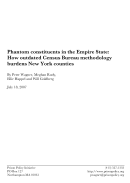
Importing Constituents:
Prisoners and Political Clout in Wisconsin
By John Hejduk and Peter Wagner
Prison Policy Initiative
March 2008
Section:
I. Introduction
The Census Bureau counts Wisconsin prisoners as if they were residents of the communities where they are incarcerated, even though they can’t vote and remain legal residents of the places they lived prior to incarceration.
Crediting thousands of mostly urban and minority men to other communities has staggering implications for modern American democracy, which uses the Census to apportion political power on the basis of equally-sized state and county legislative districts.
Until recently, it didn’t matter where the Census Bureau counted prisoners. As recently as 1980, the Wisconsin prison system had less than 4,000 prisoners, compared to 5 times as many in 2000.[1] Using population as the sole measure of political apportionment in state and local government is also quite new. Counting prisoners as residents of the facility might have made sense in the country’s first century, when the mandate of the Census was limited to determining the relative populations of states. But today, state legislatures use the Census to apportion political power within each state.
But Wisconsin, like most states, says that prison is not a residence. A legal residence is the place that people choose to be and do not intend to leave.[2] The statutes are explicit: when people leave home temporarily with an intent to return, they retain their former residence.[3] Since prisoners do not choose the prison and will return home the minute they are released from custody, their legal residence remains at their pre-incarceration address. While the Census Bureau counts most people at their legal residences, its method of counting prisoners is in fundamental opposition to how most states define residence.
Today, our conception of democracy requires far more detailed and accurate data to reflect where the population — including people in prison — actually lives. In almost every respect, except for how it counts people in prison, the Census Bureau’s methodology has evolved to keep pace with the changing needs for its data. But now that such a large percentage of the population is incarcerated, where the Census Bureau counts people in prison is a question of critical importance.
Footnotes
[1] Ann L. Pastore and Kathleen Maquire eds., Sourcebook of Criminal Justice Statistics 2003, Table 6.29, 501 (2005) and U.S. Census 1980 and 2000.
[2] “The residence of a person is the place where the persons habitation is fixed, without any present intent to move, and to which, when absent, the person intends to return.” Wis. Stat. § 6.10 at P 1 (2002).
[3] “A person shall not lose residence when the person leaves home and goes into another state or county, town, village or ward of this state for temporary purposes with an intent to return.” Wis. Stat. § 6.10 at P 5 (2002).
Events
- April 15-17, 2025:
Sarah Staudt, our Director of Policy and Advocacy, will be attending the MacArthur Safety and Justice Challenge Network Meeting from April 15-17 in Chicago. Drop her a line if you’d like to meet up!
Not near you?
Invite us to your city, college or organization.



